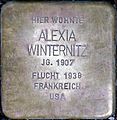Friderike Maria Zweig


Friderike Maria Zweig , also Friederike Maria Zweig , née Friederike Maria Burger , (born December 4, 1882 in Vienna , † January 18, 1971 in Stamford , Connecticut , USA ) was an Austrian writer. She was Stefan Zweig's first wife and also worked as a journalist , teacher and translator.
Life
Friderike Burger was the daughter of Emanuel Burger (1844–1902) and Theresia Elisabeth Burger (nee Feigl; 1844–1923), she studied literature and French at the University of Vienna . Under her first married name, Friderike von Winternitz , she emerged as an author from 1902, published several novels and wrote for Westermanns Monatshefte , the Wiener Zeitung and the Vossische Zeitung . During the First World War , which she considered a crime, she organized the International Committee for Lasting Peace . This also brought her close to Stefan Zweig, who stood up for humanity and peace beyond any political party or religious community.
Her first marriage was to the tax officer Felix Edler von Winternitz (1877-1950), from whom she divorced in 1914. In 1905 she converted from the Jewish to the Roman Catholic faith. The couple had two daughters, Alice Elisabeth (Alix, Lix) Winternitz, married. Störk (1907–1986), and Susanna Benediktine (Suse) Winternitz, married. Höller (1910-1998).
In 1920 she married the writer Stefan Zweig (1881–1942), whom she had already met in 1912. The decisive factor was a novel she wrote, entitled Little Bird , which had obviously made a strong impression on him. During the years of marriage in Salzburg, she put her literary and journalistic work on hold in favor of supporting her husband. She later wrote biographical works about him.
In the last years of their marriage, Stefan Zweig had pushed through the sale of the joint home on the Kapuzinerberg in Salzburg ( Paschinger Schlössl ). So Friderike and her two daughters had to look for other accommodation. She found this from June 1, 1937 in the large villa of Alois and Luise Staufer in Nonntaler Hauptstrasse 49 next to the Römerwirt. Her husband had forbidden her from registering there herself (he was involved in tax disputes with the Salzburg authorities and no longer wanted to have any residence in the city); however, the two stepdaughters were reported there.
After her divorce from Stefan Zweig (1938), she emigrated first to France and in 1940 to the USA, where she also worked as a translator. a. by Émile Verhaeren and Anatole France . Until Stefan Zweig's suicide, she stayed in close correspondence with him and there were frequent personal meetings with him and his new wife, Lotte Altmann . In the USA she founded the Writers Service Center in 1943, the purpose of which was to provide assistance to displaced people. In 1954 she founded the "American-European-Friendship-Association". She was honorary president of the "International Stefan Zweig Society".
Publications
- Call of home . 1914.
- Little bird . 1919.
- Louis Pasteur . 1939.
- Stefan Zweig - How I experienced him. FA Herbig Verlag, Berlin 1948.
- Stefan Zweig - A picture biography. Kindler Verlag, Munich 1961.
- Reflections of life. Life memories. Fischer-Taschenbuch-Verlag, Frankfurt a. M. 1985, ISBN 3-596-25639-9 . First edition: Deutsch-Verlag, Vienna 1964.
literature
- Harry Zohn (Ed.): Liber Amicorum - Friderike Maria Zweig. In Honor of her Seventieth Birthday. Dahl. Stamford 1952.
- Susanne Blumesberger, Michael Doppelhofer, Gabriele Mauthe: Handbook of Austrian authors of Jewish origin from the 18th to the 20th century . Volume 3: S – Z, Register. Edited by the Austrian National Library. Saur, Munich 2002, ISBN 3-598-11545-8 , p. 1526.
- Jeffrey B. Berlin , Gert Kerschbaumer (eds.): Stefan Zweig - Friderike Zweig. "When the clouds give way for a moment". Correspondence 1912–1942. Fischer, Frankfurt am Main 2006, ISBN 3-10-097096-9 .
Web links
- Literature by and about Friderike Maria Zweig in the catalog of the German National Library
- Friderike Maria Zweig ( Memento from February 10, 2013 in the web archive archive.today ) in the central directory of digitized prints (zvdd)
- Literature list in the online catalog of the Berlin State Library
- Andreas Weigel : Literary search for traces in Gars-Thunau or what connects Karl Kraus , Heimito von Doderer and Stefan Zweig with the summer vacation in the Kamptal.
- Friderike Zweig in the archive of the Austrian Media Library
Individual evidence
- ↑ Friderike M. Zweig: Stefan Zweig - How I experienced him. 1948, p. 110.
- ↑ Anna L. Staudacher: "... announces the departure from the Mosaic faith". 18,000 withdrawals from Judaism in Vienna, 1868–1914: names - sources - dates. Peter Lang, Frankfurt / M. u. a. 2009, ISBN 978-3-631-55832-4 , p. 90.
- ^ Review by Leonhard Adelt in the Berliner Tageblatt of January 25, 1920
- ↑ Friderike M. Zweig: Stefan Zweig - How I experienced him. 1948, p. 125.
- ↑ The memorial plaque contains the name of Friderike from the first marriage. This is incorrect insofar as she continued to call herself Friderike Zweig with the express permission of her husband.
- ^ Gert Kerschbaumer : Stefan Zweig. The flying Salzburg man. Salzburg, Residenzverlag, 2003, ISBN 3-7017-1336-7 , p. 384.
- ↑ Herbert Lackner : The flight of the poets and thinkers. In: News magazine profile. Edition 15/2015, p. 35.
- ↑ International Stefan Zweig Society stefan-zweig.sbg.ac.at ( Memento from July 13, 2011 in the Internet Archive )
| personal data | |
|---|---|
| SURNAME | Zweig, Friderike Maria |
| ALTERNATIVE NAMES | Zweig, Friederike Maria; Burger, Friederike Maria (maiden name) |
| BRIEF DESCRIPTION | Austrian writer |
| DATE OF BIRTH | 4th December 1882 |
| PLACE OF BIRTH | Vienna |
| DATE OF DEATH | 18th January 1971 |
| Place of death | Stamford , Connecticut , USA |







